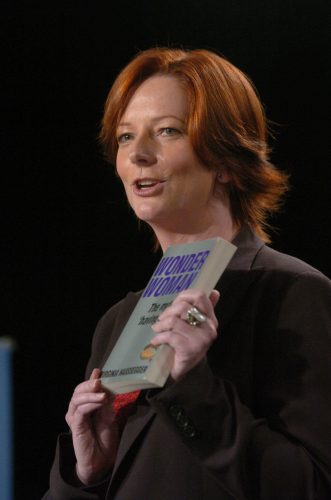There’s nothing quite like a depressed American woman in tears, a stressed-out Chinaman, and a beautiful Aboriginal boy, to get us all wondering “what the bloody hell is this?”
You can almost hear the marketing gurus around the boardroom table at Tourism Australia as they tried to figure out their latest advertising campaign.
“Well, humour didn’t bloody work last time, did it?”
“No, Jack, it wasn’t just the humour. It was the use of profanities like ‘bloody’ and ‘hell’ that upset the Americans, shocked the Canadians, and got up the nose of the Poms. And as for the Asians, well, they just didn’t get it.”
“But, Jill, it was supposed to be funny. I mean, if we can’t say ‘where the bloody hell are you?’ what the hell can we bloody well say?”
“Dunno, Jack. Bloody depressing really, isn’t it?”
Just then, the gurus struck gold. If humour doesn’t work, go for misery.
And that’s what Tourism Australia’s new $50 million campaign, unveiled this week, has done.
With a sharp eye for the capital value of personal misery, filmmaker Baz Luhrmann has zoomed in on stressed, cashed-up executives, who can’t hold down a relationship, and can’t stop working. They’re the perfect target: rich, lonely, unimaginative and desperately in need of a break. In a glamorous but brief 90 seconds, Luhrmann takes the viewer on a rollercoaster of emotion: from scenes of desperation over a late night laptop, to happy ever after hugs in outback Australia. This massively vast and empty place is apparently where crazed workaholics will commune with nature, find themselves, and mend their tatty souls.
It’s romantic, sweet and very silly. Silly in concept and also silly in target.
Australia’s tourism numbers are static. In the year to August, we had almost 5.7 million international tourists visit. Other than New Zealanders, who account for 1.3 million neighbourly visitors, our biggest tourism imports are Brits. Last year 682,000 British tourists visited Australia, which was a 7 per cent drop on the previous year.
Perhaps that’s why Tourism Australia has launched its campaign in Britain first, with one of Luhrmann’s two ads going to air there this week. Not hasty in judgment, the most the British press has said about the ad is that it “could not be more different from its controversial predecessor”.
The ad they’re seeing shows Aussie actress Sibylla Budd as a stressed-out New York executive, barking orders into her mobile phone, as she skirts manic traffic in the pouring rain. Her lover, boyfriend, or possibly distant husband, calls to chastise her for working late. “It’s always work,” he bellows down the line. He then tells the weeping woman, now seated in a bleak apartment, that she’s no longer the person he fell in love with. Nice. He tells her they need a break.
Frankly, I think she should tell him to go jump. But she doesn’t.
Instead, magically, an exquisite Aboriginal boy appears and whispers into the woman’s ear something about getting lost to find ourselves, and going walkabout. Personifying purity and ancient spirituality, the little boy then scatters red ochre dust on to her hand. Next we see the manic New Yorker swimming in a beautiful Australian billabong, holding a man.
The second ad, set in Shanghai, is the same kind of scenario. But here the manic workaholic is a Chinese bloke, whose girlfriend has walked off in a huff, and he returns to a dark, bleak office. Same little Aboriginal boy and same message. But this time the stressed executive is transported to an outback bush dinner for two, where his lover is dancing on the table and the two of them climb a tree. Again, a ludicrous scenario, but a very Hollywood ending.
Anyone coming to Australia expecting these sort of romantic outcomes will be mightily disappointed. To be able to afford this kind of trip and these personalised adventure experiences, a tourist would need to be seriously cashed up. Most Australians can’t afford the charter flight, 4WD hire and tour guide costs it would take to locate that kind of blissful billabong, and we live here. Nor could most of us afford the kind of gourmet bush dinner for two, laid out with candles, lanterns and crystal glasses, in the middle of no-where, presumably with waiters on hand to serve and clean up. It’s fanciful stuff, which once again it would take a Shanghai executive to afford.
The so-called “walkabout” experiences that Tourism Australia is promising have all the glitter of magic dust, but in reality are, well not real.
Unless, of course, you happen to be a black Amex card-carrying millionaire and thus you can purchase any fantasy you want.
So, what kind of tourists will be enticed by these ads? Those who are stressed to the point of tears, and rich enough to charter planes and hire helicopters to reach gloriously remote outback places of breathtaking beauty? Or those who covet that kind of glam lifestyle and will come in the hope of finding it?
Sadly, what the average tourist will find instead of dreamy Aboriginal children, who scatter mystical dust, is a much uglier notion of dreamtime: a cheap commercialisation of Aboriginal culture and impoverished communities living in Third World conditions.
But for those adventurous types who head outback anyway, in an effort to get lost and “go walkabout”, the journey may still involve self- discovery. You may well discover the limits of your endurance, when faced with all that heat, dust and long, dull hours on a Greyhound bus.






